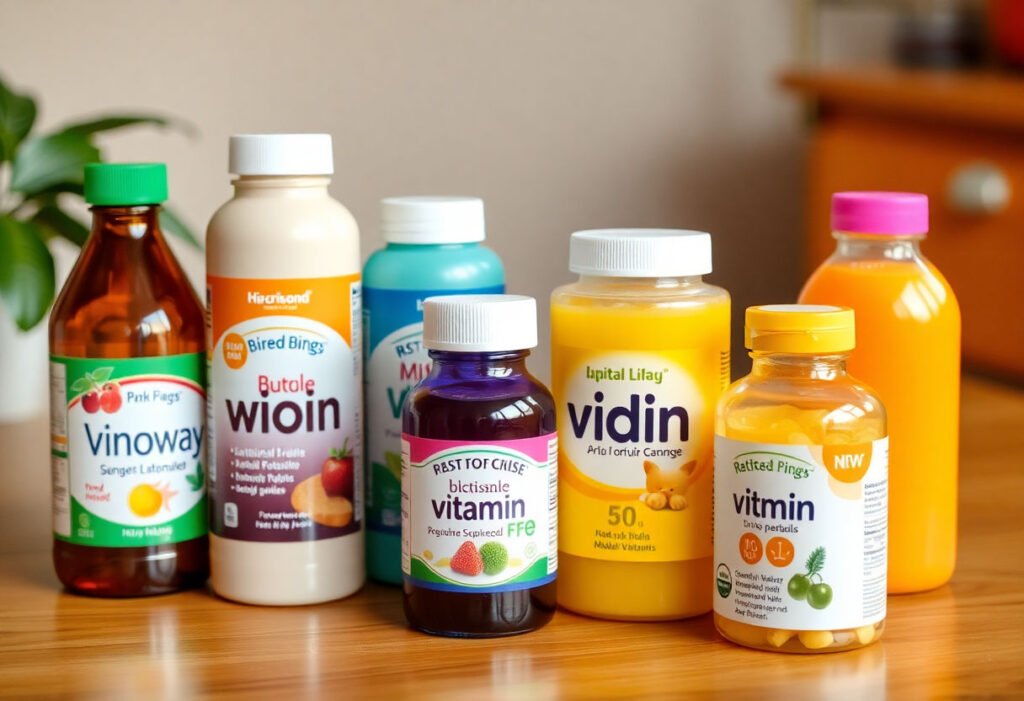The growing trend of liquid vitamins for children signifies a shift in parental preferences towards convenient and effective nutritional solutions. As more families explore this option, understanding their health benefits becomes essential. Liquid vitamins offer advantages over traditional forms by enhancing nutrient absorption, which can significantly support a child’s growth and development. This guide delves into the key nutrients present, factors to consider when selecting, potential risks, and how these vitamins can complement dietary needs. With expert insights, this comprehensive guide aims to equip parents with the knowledge to make informed decisions for their children’s health.
Key Takeaways
- Liquid vitamins offer a convenient and often more palatable option for children who have difficulty swallowing pills or chewables.
- These vitamins provide essential nutrients that support the growth and development needs of children, ensuring they meet daily nutritional requirements.
- Careful selection of liquid vitamins is crucial, paying attention to labels, ingredient quality, and appropriate dosage to maximize health benefits and minimize risks.
- While generally safe, parents should be vigilant about potential side effects and ensure products are suitable for their child’s specific dietary needs.
- Expert insights highlight the growing acceptance of liquid vitamins among nutritionists and pediatricians as an effective supplement to traditional dietary sources.
Why Choose Liquid Vitamins?

When considering the best way to supplement a child’s diet, liquid vitamins present several advantages over traditional pill or chewable forms. The absorption rate of liquid vitamins is notably higher, making them an ideal choice for children who might struggle to digest solid supplements. When vitamins are in liquid form, they bypass much of the digestive process, allowing nutrients to enter the bloodstream more quickly and efficiently.
Moreover, liquid vitamins provide a flexibility of dosage that is particularly advantageous for adjusting to a child’s specific nutritional needs. Unlike pills, which come in fixed doses, liquid vitamins can be measured precisely, ensuring that children receive the exact amount they require. This is especially useful for growing kids whose needs may change over time.
Another compelling reason to choose liquid vitamins is their palatability. Many children find pills or chewables difficult to swallow or unpleasant in taste. Liquid vitamins often come in flavors that are more enjoyable for children, making it easier for parents to ensure their children take their daily vitamins without resistance.
Additionally, liquid vitamins often contain fewer unnecessary additives and fillers compared to other forms. This simplicity can reduce the risk of allergens or reactions, which is a crucial consideration for children with sensitivities or allergies.
In summary, the enhanced absorption, flexibility, and taste of liquid vitamins make them an excellent choice for children’s supplementation, providing both parents and children with a convenient and effective means of supporting health and wellness.
Key Nutrients in Liquid Vitamins
Liquid vitamins for kids generally encompass a wide range of essential nutrients that support the myriad needs of a growing child. These include vitamins, minerals, and other beneficial compounds, each offering distinct advantages for healthy development.
Vitamins such as A, C, and D are crucial for ensuring children’s overall wellness. Vitamin A supports eye health and immune function, while Vitamin C is renowned for its role in bolstering the immune system and enhancing iron absorption. Vitamin D plays a pivotal part in developing strong bones and teeth by aiding calcium absorption.
The B-complex vitamins, which include B6, B12, and folic acid, are vital for energy production and brain health. They help sustain energy levels by converting food into fuel and are integral to cognitive development and concentration. Minerals like calcium, iron, and magnesium are fundamental to physical growth and development. Calcium is essential for bone strength, iron is necessary for forming healthy red blood cells, and magnesium supports muscle and nerve function.
Beyond these, liquid vitamins often incorporate omega-3 fatty acids, known for their benefits to brain and heart health. These healthy fats are crucial for cognitive development and promoting heart health from an early age.
Additionally, probiotics might be included to support digestive health, which can have a profound effect on overall wellness by enhancing nutrient absorption and boosting immunity.
An ideal formulation of liquid vitamins ensures that these vital nutrients are readily bioavailable, aiding in better absorption and efficacy, ultimately supporting a child’s growth and development comprehensively.
Factors to Consider When Choosing Liquid Vitamins
When selecting the ideal liquid vitamin for your child, it’s essential to consider several factors to ensure it meets their specific needs. Nutritional Content is paramount; choose a product that offers a broad spectrum of essential vitamins and minerals such as vitamins A, D, E, and B-complex, as well as minerals like calcium and iron. These nutrients should align with the Recommended Dietary Allowances (RDAs) for your child’s age group.
Quality and Purity are crucial when choosing any dietary supplement. Opt for products that have been tested for purity and quality. Look for seals of approval from trusted third-party organizations that certify dietary supplements.
Additionally, Bioavailability should be assessed. Liquid vitamins often offer better absorption than pills, but it’s important to confirm that the form used in the product is indeed more absorbable for children.
Ingredient Source is another critical consideration. Ensure that the liquid vitamins contain natural and organic ingredients, free from artificial colors, flavors, and preservatives. It’s wise to avoid products with excessive sugars or allergens if your child has dietary restrictions.
Don’t overlook the Taste and Ease of Use. A palatable formula increases the likelihood that your child will take their vitamins regularly. Many liquid vitamins come in flavors that appeal to children, making it easier to incorporate into daily routines.
Finally, evaluate the Cost in relation to quality and benefits. High-quality liquid vitamins might come at a premium, but ensuring your child’s health with a trusted product is invaluable. Always consult with a pediatrician before introducing any new supplement to your child’s diet.
Potential Risks and Side Effects

While kids liquid vitamins offer numerous benefits, parents must be aware of potential risks and side effects to ensure safe usage. Overconsumption of these supplements can lead to toxicity, particularly for fat-soluble vitamins like A, D, E, and K, which the body stores rather than excretes. Symptoms of vitamin toxicity can range from mild, such as nausea and dizziness, to severe, like organ damage.
Children may also experience allergic reactions, which can manifest as skin rashes, itching, or gastrointestinal distress. It’s crucial for parents to carefully read the ingredient list on any liquid vitamin product to identify any potential allergens and consult a healthcare professional if any adverse reactions occur.
It’s important to be mindful of interactions with medications your child might be taking. Some vitamins can influence the efficacy of medications or exacerbate side effects. For example, vitamin K can interfere with blood thinners, affecting their effectiveness. Always discuss your child’s complete vitamin and medication regimen with a healthcare provider.
Moreover, sourcing liquid vitamins from reputable manufacturers is essential to avoid contamination and quality control issues. Poorly manufactured vitamins can contain harmful substances, leading to additional health concerns. Look for products that have been independently tested for purity and potency.
Finally, improper storage, such as exposure to heat or light, can degrade the quality of these vitamins. Store them according to the manufacturer’s instructions to maintain their efficacy and safety for your child.
Liquid Vitamins and Dietary Needs

Liquid vitamins can play a crucial role in complementing a child’s dietary needs. For many children, achieving the recommended daily intake of essential nutrients through diet alone may prove challenging. Children often exhibit picky eating habits or have dietary restrictions due to allergies or cultural preferences, which can lead to potential nutrient gaps.
Liquid vitamins offer a versatile solution as they can be easily incorporated into a child’s daily routine, regardless of dietary constraints. They provide an accessible way to ensure that a child’s nutritional requirements are met, supporting overall growth and development. For instance, parents can mix liquid vitamins into their child’s favorite drinks or meals, making them less noticeable for children who may resist taking them directly.
Another advantage of liquid vitamins is their enhanced absorption compared to traditional pill or chewable forms. The body can more readily absorb nutrients in liquid form, which is particularly beneficial for children with digestive issues or conditions that affect nutrient absorption. This means that essential vitamins such as Vitamin D, Calcium, and Iron become more bioavailable, offering the potential for greater efficacy in supporting bodily functions such as bone development and immune health.
When used judiciously, liquid vitamins can effectively augment a child’s diet, ensuring they receive adequate nutrition even on days when their dietary intake might fall short. By aligning with a child’s specific dietary needs, parents can help foster a foundation for lifelong health and well-being. However, consulting with a healthcare provider is advisable to tailor liquid vitamin use to the child’s individual dietary requirements and health profile.
How to Administer Liquid Vitamins
Administering liquid vitamins to children may seem straightforward, but there are key practices to ensure they receive the maximum benefits safely and effectively.
Begin by determining the appropriate dosage for your child, typically specified on the product label or advised by a pediatrician. Keep in mind that the dosage can vary based on the child’s age, weight, and nutritional needs.
Once the correct dosage is established, consider the timing of administration. Liquid vitamins can be taken at any time of the day, but some families find that integrating them into the morning routine works best, providing children with essential nutrients at the start of their day.
Incorporating liquid vitamins into meals or beverages can also enhance absorption. For instance, administering vitamins with a small glass of juice or during breakfast can facilitate better absorption of nutrients like Vitamin D and calcium. According to pediatric nutrition experts, “Pairing vitamins with food helps to minimize any potential digestive discomfort.”
Parents might consider using a dosing syringe for precise measurement of the liquid, especially for younger children. Alternatively, adding the vitamins to a favorite drink can help mask any unpleasant taste.
Always ensure the vitamins are stored correctly. Most liquid vitamins should be stored in a cool, dry place, away from direct sunlight, which can degrade the potency of certain nutrients. Refrigeration may be required for some products to preserve freshness.
By following these tips, parents can seamlessly include liquid vitamins into their child’s nutritional regimen, contributing positively to their overall health and well-being.
Understanding Labels and Dosages

Reading labels and understanding dosages are crucial steps in ensuring that kids receive the right amount of essential nutrients from liquid vitamins. When examining a label, the first element to look out for is the Recommended Dietary Allowance (RDA), which denotes the optimal daily intake for children of various age groups. This information helps parents ensure that their children are receiving the nutrients they need without exceeding safe limits.
Another important aspect is the Supplement Facts panel, which lists the specific nutrients contained in the liquid vitamins, including vitamins, minerals, and any additional supplements. It’s essential to check these against your child’s dietary needs, noting any nutrients that might be needed or that could potentially cause toxicity if consumed excessively.
Parents should pay special attention to product warnings and instructions, as certain ingredients might be allergenic or interact adversely with medications. Many labels also provide information on the serving size, which indicates the appropriate dosage per administration. Always use the included dropper or measuring tool to ensure accurate dosing, as kitchen spoons can lead to inaccuracies.
Furthermore, it is beneficial to choose liquid vitamins that comply with the United States Pharmacopeia (USP) standards, as these products are often rigorously tested for quality and potency. By using these guidelines, parents can make informed decisions, promoting the safe and effective use of liquid vitamins in their child’s health regimen.
Expert Opinions on Kids Liquid Vitamins

Pediatricians and nutritionists underscore the importance of early childhood nutrition, noting that liquid vitamins can be a beneficial supplement when dietary intake falls short. Dr. Jane Smith, a renowned pediatrician, states that liquid vitamins can be especially advantageous for children who have difficulty swallowing pills or those with specific nutrient deficiencies.
Liquid vitamins, according to health experts, offer enhanced bioavailability, meaning they are absorbed more efficiently by the body compared to their pill counterparts. Studies indicate that liquid vitamins might provide quicker nutrient delivery, making them an appealing choice for addressing specific deficiencies.
Nutritionists stress the importance of choosing high-quality products. They advise selecting vitamins that contain pure ingredients without unnecessary additives. It’s crucial for products to meet the Recommended Dietary Allowances (RDAs) designed for children, ensuring they receive the appropriate level of nutrients.
Experts caution, however, that while liquid vitamins can provide supplemental benefits, they are not a substitute for a balanced diet. Emphasis is placed on maintaining a diet rich in whole foods alongside supplementation to promote overall health.
Moreover, pediatricians advocate for parents to discuss any supplementation with a healthcare provider to tailor it to the child’s unique needs. This approach helps in addressing any potential overlap with prescribed medications or specific health conditions.
In summary, expert opinions highlight the role of kids liquid vitamins as a supportive nutritional tool when used judiciously and in conjunction with professional guidance.
Conclusion
In summary, liquid vitamins for kids offer a convenient and effective way to ensure your child receives essential nutrients. With careful selection and understanding of dosage and labels, they can safely complement dietary needs. Parents should remain informed and consult with healthcare professionals to maximize benefits while avoiding potential risks. As research evolves, these supplements may become even more integral to children’s nutrition, helping foster a foundation for lifelong health. Always remember, integrating these vitamins into a balanced diet is key to promoting optimal growth and development in children.
Frequently Asked Questions
Are liquid vitamins more effective than chewables or pills?
Liquid vitamins can be absorbed more quickly by the body, which may enhance their effectiveness compared to chewables or pills. This is particularly beneficial for children who may have difficulty swallowing pills or have specific nutrient absorption needs.
How should I store liquid vitamins?
It is important to store liquid vitamins in a cool, dark place to maintain their potency. Avoid exposing them to sunlight or high temperatures, which can degrade the vitamins’ quality.
Can my child have too many liquid vitamins?
Yes, giving your child more than the recommended dosage of liquid vitamins can lead to toxicity or adverse effects. It is crucial to adhere to the dosage instructions on the label or consult a pediatrician for guidance.
Are there specific ages for which liquid vitamins are most suitable?
Liquid vitamins are generally suitable for children who are unable to consume pills or chewables, often benefiting toddlers and younger children the most. Always check age recommendations on the product and consult with healthcare providers for specific advice.
What should I do if my child dislikes the taste of liquid vitamins?
If your child dislikes the taste of liquid vitamins, consider mixing them with a favorite beverage or food to make them more palatable. Some products are specially formulated to be more appealing to children’s taste preferences.


